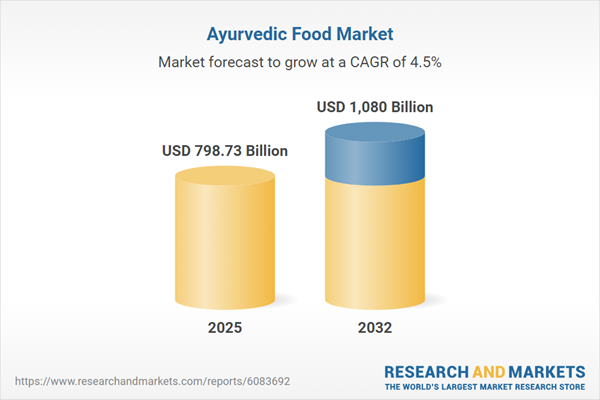Speak directly to the analyst to clarify any post sales queries you may have.
The Ayurvedic Food Market is evolving rapidly as consumer priorities shift toward holistic, plant-based nourishment and evidence-backed wellness. Senior decision-makers must keep pace with transformations in consumer behavior, product development, and regulatory change to drive sustainable success and competitive advantage.
Market Snapshot: Ayurvedic Food Market Size and Growth Overview
The Ayurvedic Food Market expanded from USD 763.90 billion in 2024 to USD 798.73 billion in 2025. Looking ahead, the sector is projected to reach USD 1.08 trillion by 2032, driven by a compound annual growth rate (CAGR) of 4.50%. Sustained momentum comes from Ayurveda’s ongoing integration into mainstream wellness, with consumer interest steadily shifting from traditional remedies to products validated by science and tailored to modern dietary needs.
Scope & Segmentation
- Distribution Channels: Offline channels include direct sales, pharmacies, specialty stores, and supermarkets/hypermarkets; online channels feature company websites and e-commerce marketplaces.
- End User Segments: Adults, children, and senior citizens each prioritize health goals such as digestive support, cognitive function, or targeted nutritional supplementation.
- Ingredient Types: Herbal extracts, nutraceuticals, and probiotics serve a wide array of functional benefits and wellness applications across consumer groups.
- Packaging Types: Bottles, pouches, and sachets address different consumer expectations, offering convenience, precise dosing, or portability.
- Certifications: Halal, Non GMO, and Organic certifications indicate product purity and support buyer confidence in rapidly expanding markets.
- Price Ranges: Economy, mid-range, and premium tiers meet the purchasing needs and brand loyalty of various demographic groups.
- Product Forms: Capsules—including hard and soft variants—gummies, liquids, powders (either multi-herb blends or single herb), and both coated and uncoated tablets create a versatile consumption landscape.
- Applications: Products are tailored for digestive health, immunity enhancement, nutritional supplementation (such as protein and vitamin fortification), skin health, and weight management, aligning closely with top wellness priorities.
- Geographical Regions: The market spans the Americas (including North and Latin America), Europe, Middle East, Africa, and Asia-Pacific, with the United States, India, and China representing key growth territories.
- Leading Companies: Prominent players include Patanjali Ayurved Ltd., Dabur India Ltd., Zandu Pharmaceuticals Works Ltd., Shree Baidyanath Ayurved Bhawan Pvt. Ltd., The Himalaya Drug Company, Kerala Ayurveda Limited, Arya Vaidya Sala Kottakkal, and Organic India Pvt. Ltd.
Key Takeaways for Senior Decision-Makers
- Personalized, plant-based nutrition is rising in importance as customers show greater interest in Ayurveda underpinned by scientific research and validated efficacy.
- Technology is central to innovation—advancements like microencapsulation and time-release delivery improve product integrity, with upgraded traceability measures boosting transparency and trust.
- Channel dynamics are evolving, with digital platforms and subscription services broadening reach, while in-person retail outlets provide crucial opportunities for product education and customer engagement.
- Market success increasingly depends on harmonizing authentic Ayurvedic formulation practices with clinical validation and internationally recognized certifications, supporting regulatory compliance and consumer trust.
- Strategic alliances spanning e-commerce, mobile applications, and supply chain technology partners encourage ongoing product innovation, raise supply chain resilience, and expand market accessibility, especially in fast-changing regions.
- Regional diversity in consumer preferences and evolving regulatory requirements create opportunities for adaptive market segmentation and agile compliance strategies in global expansion efforts.
Tariff Impact: Responding to Regulatory and Trade Changes
Recent tariffs imposed by the United States on imported botanical ingredients are affecting operational margins and sourcing strategies for market participants. Companies are addressing this by diversifying supplier bases, increasing investments in regional cultivation, and sharpening procurement tactics. These steps enable firms to maintain pricing consistency and supply continuity even as global trade conditions fluctuate.
Methodology & Data Sources
This report’s conclusions draw from expert interviews, consumer ethnography, and robust analysis of peer-reviewed publications, trade databases, and patent literature. Proprietary triangulation and systematic cross-checking strengthen the accuracy and reliability of insights delivered.
Why This Report Matters
- Delivers comprehensive, executive-focused analysis of evolving consumer preferences, product developments, and regulatory requirements shaping the Ayurvedic Food Market.
- Empowers leaders to navigate technology-driven shifts, adapt to collaboration models, and respond to multi-layered geographic market dynamics with informed, agile strategies.
- Facilitates sound risk management through independent evaluation of regulatory trends, supply chain transformations, and competitor benchmarking.
Conclusion
The Ayurvedic Food Market stands at the intersection of long-standing traditions, scientific advancement, and modern consumer needs. Decision-makers harnessing innovation and compliance while adapting distribution strategies will secure lasting market relevance and continued growth.
Table of Contents
3. Executive Summary
4. Market Overview
7. Cumulative Impact of Artificial Intelligence 2025
Companies Mentioned
The companies profiled in this Ayurvedic Food market report include:- Patanjali Ayurved Ltd.
- Dabur India Ltd.
- Zandu Pharmaceuticals Works Ltd.
- Shree Baidyanath Ayurved Bhawan Pvt. Ltd.
- The Himalaya Drug Company
- Kerala Ayurveda Limited
- Arya Vaidya Sala Kottakkal
- Organic India Pvt. Ltd.
Table Information
| Report Attribute | Details |
|---|---|
| No. of Pages | 186 |
| Published | October 2025 |
| Forecast Period | 2025 - 2032 |
| Estimated Market Value ( USD | $ 798.73 Billion |
| Forecasted Market Value ( USD | $ 1080 Billion |
| Compound Annual Growth Rate | 4.5% |
| Regions Covered | Global |
| No. of Companies Mentioned | 9 |









